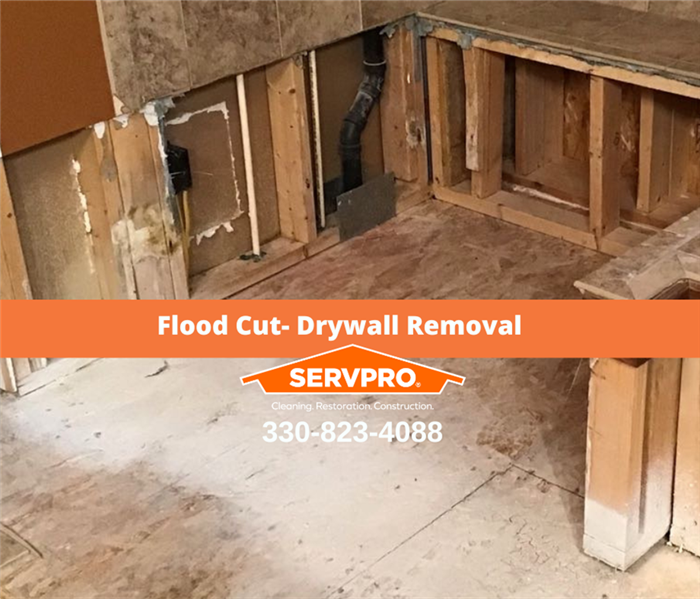Why a Flood Cut is Necessary After a Water Damage
3/10/2023 (Permalink)
When you experience a severe water damage in your home or in your commercial building, it could leave your property in a state of disarray. To get the room back to preloss condition, a professional restoration company in Alliance, OH may need to cut out the drywall known as a flood cut. The reason this is called a flood cut is because the cut is made 12-18 inches above where the flood damage stops. It is done to facilitate drywall tear out. This will allow proper air flow to ensure thorough drying.
When a Flood Cut Is Necessary
- When the Water Is Contaminated by raw sewage, fecal matter, chemicals, or other forms of contamination.
- The water damage is too severe to save the wall.
- It isn't practical to dry out the wall without removing sections.
- When the walls contain insulation, because insulation cannot be dried out and still function properly as insulation.
How to Perform a Flood Cut
Step 1: Mark a straight line: Measure from the floor to a decided upon height. Make a mark at this height at various areas along the affected walls. Using a chalk line, connect the marks on the wall to create a straight line at the decided upon height.
Step 2: Using a utility knife cut along the chalk line. Score the line through the surface of the drywall all along this chalk line, cutting one half or three quarters of the way through the thickness of the drywall.
Step 3: Carefully loosen and remove the damaged drywall. Using a hammer carefully knock a small hole in the drywall below this line. Gently remove the drywall, by using the drywall as a handle. Move the drywall back and forth to loosen it from the studs behind.
Step 4: Remove any wet insulation. After all drywall is removed, completely discard any damp insulation. It is easy to be fooled by the moisture content of insulation. It may seem only slightly damp when in actuality it should be removed. If in doubt, remove all the insulation in the walls. It is one of the least expensive things to replace and it is worth removing it now to avoid the potential of leaving some moisture behind the walls.
Step 5: Place fans for 48-72 hours. After all the damaged material has been removed, place industrial fans strategically to increase air flow behind the walls. Leave the fans running for at least a few days so the studs and flooring can completely dry.
When doing any type of demolition work, including that described above, it is important to wear proper personal protective equipment, which include gloves, safety glasses, hard soled footwear, and hard hats. Remember to turn off all electrical circuits in the area that you will be removing drywall. It is good to consult with an electrician in any cases of flood damage since water and electricity can cause potentially serious dangers.
Call SERVPRO of South & East Stark County for Water Damage Restoration
When it comes to extreme water damage, calling a professional restoration company insures that your home will be properly dried to ensure your house is safe to live. If your home or business in Alliance, OH ends up flooding, call SERVPRO of South & East Stark County to evaluate, cleanup and remediate the water damage or visit www.SERVPROsoutheaststarkcounty.com for more information.






 24/7 Emergency Service
24/7 Emergency Service
